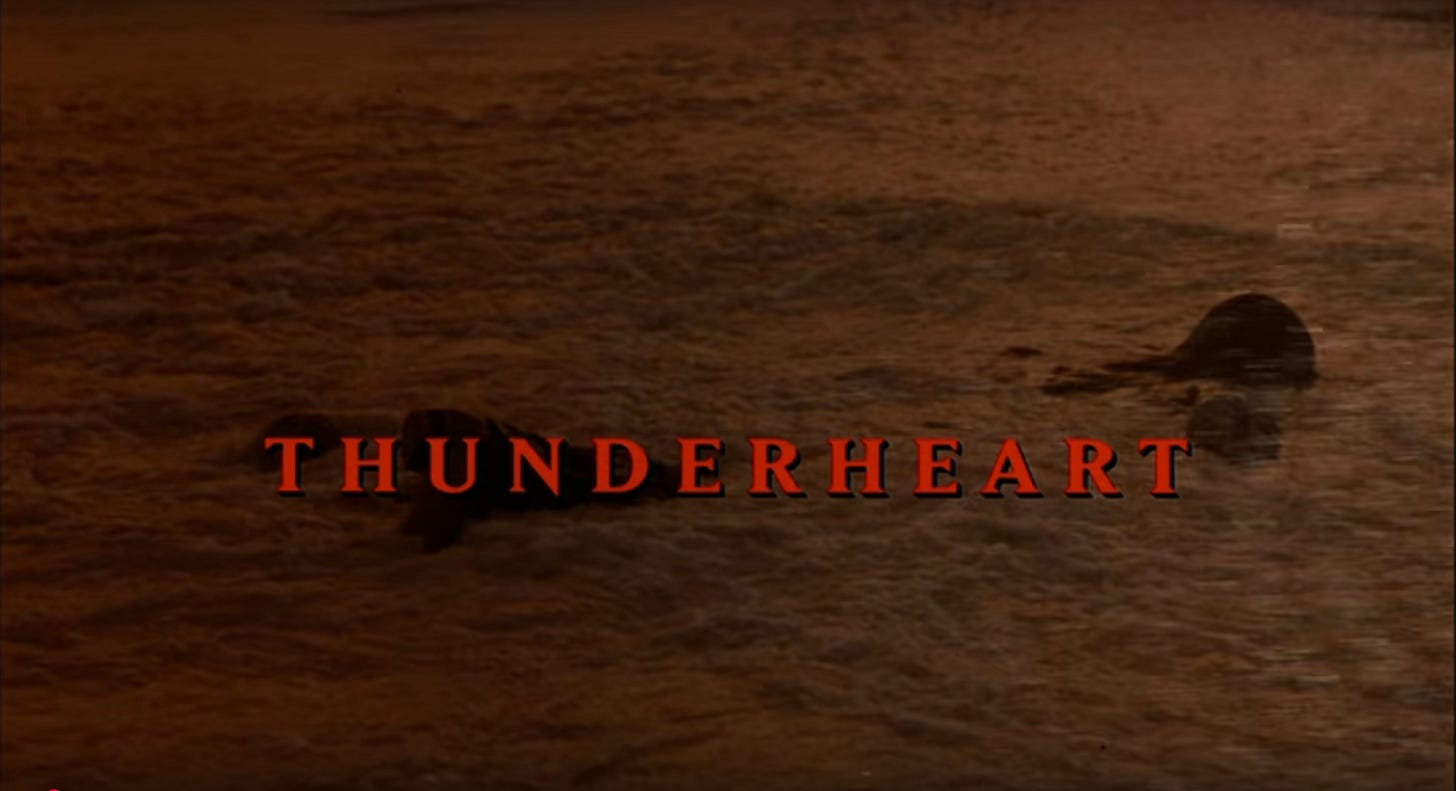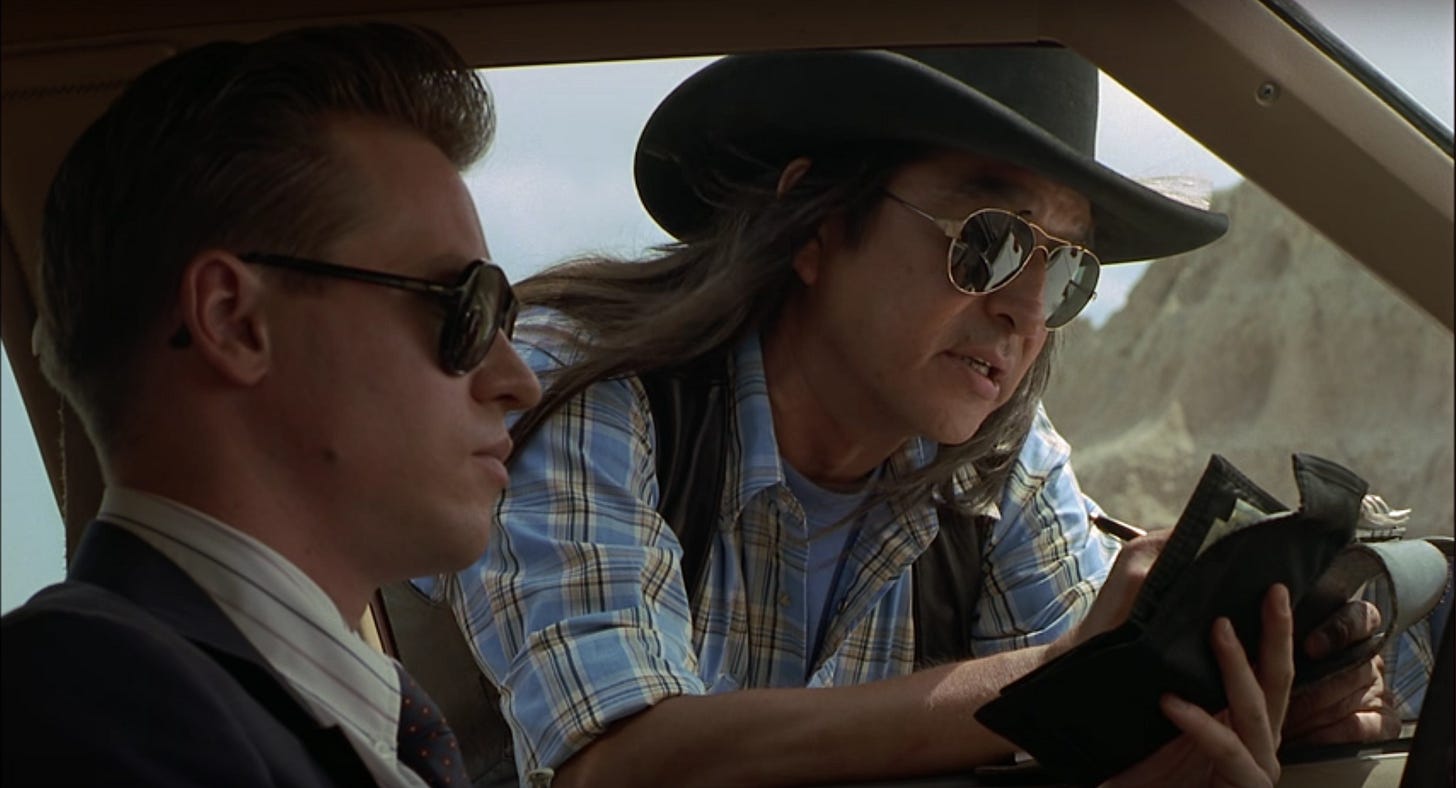Video Days orders readers to surrender their badge and gun and while suspended for the month of May, return to ten films trafficking in law and order.
THUNDERHEART (1992) was the first movie to reach theaters in the wake of Dances With Wolves (1990) reviving not just the western genre, but revisionist westerns that placed an emphasis on Native Indian history and culture. These included The Last of the Mohicans (1992), Geronimo: An American Legend (1993) and Legends of the Fall (1995). Thunderheart takes such a short reach into history that it qualifies as a contemporary take, but as such, combines a surprisingly compelling murder mystery with political intrigue, revealing the integration of native cultures into the United States was ongoing, and still being worked out with violence.
John Fusco grew up in Prospect, Connecticut, writing short stories and shooting them on his mother’s 8mm film camera. In addition to playing keyboards, Fusco realized he was a decent vocalist, and at age sixteen, he left home with a country/ blues band composed of friends calling themselves the Dixie Road Ducks, which Fusco described as a poor man’s Allman Brothers Band. After six years of traveling the Mississippi Delta, Fusco earned his GED and was ultimately accepted into the Dramatic Writing Program at New York University’s Tisch School of the Arts. His first screenplay, Blues Water, was about a young Seminole who goes in search of his roots. It won first place in the FOCUS (Films of College and University Students) competition funded by Nissan, landing Fusco a literary agent at William Morris Agency. The script didn’t sell, but his second, which won first place at FOCUS the following year and was titled Crossroads, and would not only sell to Columbia Pictures but was produced in 1986, starring Ralph Macchio as a Julliard student in classical guitar who escorts an aging bluesman to Mississippi to barter his soul back from the Devil.
In 1986, the screenwriter/ blues musician made his way to South Dakota to meet Buddy Red Bow, a Lakotan whose singing Fusco admired. Red Bow had grown up on the Pine Ridge Indian Reservation and took Fusco there to meet Frank Fools Crow, a tribal elder whose birth preceded the last military clash between the United States and the Plains Indians, the Battle of Wounded Knee, in which thirty U.S. 7th Cavalry soldiers fell and as many as three hundred Lakota Sioux perished, in 1890 near Pine Ridge in present day South Dakota. In 1973, two-hundred members of the American Indian Movement (AIM) occupied the reservation village, declaring it the Independent Oglala Sioux Nation and demanding changes in tribal leadership. In the standoff, two FBI agents were killed. For eight months, Fusco made trips from his home in Vermont to visit with Fools Crow. The more he learned of the tribe’s history, including politically motivated murders in the 1970s that had never really been solved, the more Fusco wanted to write about Pine Ridge. The medicine man gave Fusco his blessing.
Understanding that Fusco had an interest in Native Indian culture, Universal Pictures approached him to write a script in that milieu. Fusco proposed a mystery based on real events, a fictionalized account of the clashes between the FBI and American Indian Movement on Pine Ridge in the 1970s. He found the studio surprisingly receptive to the setting, but not its politics, Fusco exploring the federal government’s role in removing resistance to exploiting lucrative mineral rights on the reservation. He authored Young Guns (1988) and Young Guns II (1990), westerns about Billy the Kid and the Lincoln County Regulators, but refused to give up on his Pine Ridge script, taking the time to accurately depict the belief system, passion and sense of humor of the Lakota Sioux. Finally, in 1988, Fusco sent his script to Robert DeNiro, who with his producing partner Jane Rosenthal was launching what became Tribeca Films. They chose Fusco’s script to be their first production, and DeNiro accompanied Fusco to Pine Ridge to spend three days visiting tribal leaders. The following year, the Oglala Sioux Nation adopted Fusco, naming him Wakiyan Cante, or Thunderheart.
In 1990, after twelve years running the studio he co-founded, Orion Pictures, Mike Medavoy was named chairman of TriStar Pictures, and with Jane Rosenthal, Robert DeNiro (as Tribeca Films) and John Fusco (under his newly launched company, Waterhorse Productions) as producers, the new regime responded favorably to Thunderheart, TriStar agreeing to finance and distribution. The plot involved a young FBI agent whose Native Indian ancestry draws him an assignment to “Bear Creek Reservation” in the South Dakota Badlands, where a tribal council member has been murdered. The agent is partnered with a veteran Bureau man familiar with the skirmishes between the Washington-friendly council and the radicals pushing for change by any means necessary, and assisted by a tribal policeman conducting his own investigation into the murder. To direct, the producers approached Michael Apted, the British filmmaker who’d moved between narrative films and documentaries, chiefly his ongoing Up series, which began as a short in 1964 titled Seven Up! documenting the lives of several seven-year-olds in England, with subsequent films chronicling the subjects every seven years. Apted, as no surprise to the producers, was preparing a documentary produced by Robert Redford’s Wildwood Enterprises tentatively titled The Shootout at Jumping Bull about the imprisonment of political activist Leonard Peltier, solely indicted for the killing of the two FBI agents in the standoff at Pine Ridge. Apted was amazed to read a finished screenplay fictionalizing the events of his documentary–to be released as Incident At Oglala (1992)--and agreed to direct.
Thunderheart was the first movie granted permission to film at Pine Ridge Reservation, where location scouts and the art department arrived in early spring 1991. Val Kilmer, Sam Shepard and Graham Greene were cast as the young FBI agent, his seasoned partner and the tribal cop, respectively. In the process of making Incident At Oglala, Apted had met John Trudell, former chairman and spokesman for AIM who took part in the occupation of the reservation. The director cast Trudell, who had no professional acting experience, as “Jimmy Looks Twice,” the radical activist the Bureau considers their prime suspect. Fred Ward and Fred Dalton Thompson were cast in smaller roles, while Sheila Tousey, an actor from Wisconsin of Menominee Indian and Stockbridge-Munsee descent, was cast as the tribal activist Kilmer’s character compels to help him. Playing a variation on Fusco’s mentor was Chief Thin Red Elk, who like Trudell, had no professional acting experience. On a publicized budget of $15 million, shooting commenced in June 1991. The show was based in the town of Kadoka, South Dakota, where four prefabricated buildings placed on the edge of a vegetable garden served as a production hub and the town’s half dozen motels were booked to cast and crew for ten weeks. It was estimated that Thunderheart pumped $6 million into the local economy.
Opening April 1992, critical response to Thunderheart was overwhelmingly positive. Gene Siskel and Roger Ebert gave the film two thumbs up. Siskel compared it to Witness (1985) with its murder mystery penetrating a community segregated from the rest of the country, cited its rustic look and praised the range of Val Kilmer in the lead. Ebert acknowledged Graham Greene and the rest of the cast as well as Kilmer, and the details Apted captured on reservation life. Writing in the New York Times, Janet Maslin lauded the “anthropological accuracy” of Apted’s work, examining life on the reservation with curiosity and intelligence, sparing the Tinseltown gloss. John Hartl, a champion for independent films in his column for the Seattle Times, noted “an anger and rawness” tipped perfectly by the music chosen to begin the film: “Badlands” by Bruce Springsteen. With Basic Instinct and White Men Can’t Jump dominating the box office, Thunderheart opened in a crowded field against several new films including the family friendly Beethoven. While Apted credited the success of Dances With Wolves for allowing them to make Thunderheart, without Kevin Costner or western tropes to sell audiences, the film spent three very low key weeks among the top ten grossing movies in the country.
Thunderheart seems like the sort of movie we’ve seen before. We know there will be a gothic locale, mysterious people, and a detective who discovers something about himself. The script delivers all of that a hair under two hours, but the locale is shot with such panache and the people written with such depth that it all feels new. As opposed to our interest flagging, it deepens with each scene. Val Kilmer swings from his portrayal of a rock god in The Doors (1991) to the polar opposite: a by-the-book federal agent who loses his book and with two investigators showing him the way, has to choose which to follow. It’s a greater challenge than playing Jim Morrison because there’s no archival record to mimic, and as an FBI agent, Kilmer can’t use hair and makeup to find his character. It’s difficult to imagine an actor like Nicolas Cage or Keanu Reeves in the part after watching Kilmer. Neither Sam Shepard or Graham Greene, Academy Award nominees for Supporting Actor in previous films, have to mount a horse in this one, but are convincing as men who seem as much a part of the land as the scrub brush, each establishing characters compelling enough to be the lead. The casting then shifts into an even higher gear with Sheila Tousey, a professional actor making her film debut, as Maggie Eagle Bear, an activist and single mother, and John Trudell and Ted Thin Elk, non-professionals who’d never been cast in a movie either.
Impressively for a film shot in South Dakota, John Fusco and Michael Apted never allow Thunderheart to become static. Nothing plays out in a familiar way, whether it’s Shepard’s character putting his hand under a porch, Kilmer feeding a dog, the pair escorting Trudell’s fugitive in handcuffs, or the relationship between the “Washington Redskin” and Maggie Eagle Bear. At a certain point, we start to wonder why thrillers with greater resources are rarely this exciting. Director of photography Roger Deakins, whose most renowned work up to this point might’ve been Barton Fink (1991) and the music video for “Rockit” by Herbie Hancock, rarely calls attention to the camera, except for moments where he gives us an eagle’s eye view of the action. Apted’s work in documentary film is often cited as attributing to the verisimilitude of his best narrative films, namely Coal Miner’s Daughter (1980) and Gorillas In the Mist (1988), but Thunderheart demonstrated the director could capture a place or political situation with the finesse reserved for his biographies of famous people. Fusco deserves perhaps the most credit, his observations on life on the Pine Ridge Indian Reservation and the instruction he received there providing a tangible foundation for a compelling mystery.
Video rental category: Mystery/ Suspense
Special interest: Stranger In A Strange Land










